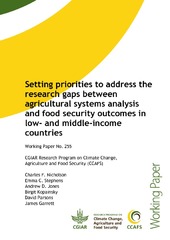| dc.description.abstract | This document assesses the current state of practice for the representation of food security indicators in agricultural systems models and provides recommendations for improvements in both model formulation and the empirical evidence base underlying it. This assessment was based on a review of existing conceptual frameworks linking agriculture and food security, the indicators most commonly used to represent food security dimensions (availability, access, utilization and stability) and studies using models to assess household and regional food security. We also undertook proof-ofconcept analyses using household-level and regional-level models incorporating food access indicators into two agricultural systems models. We found that there is a broad agreement at a conceptual level about important linkages between agricultural systems and food security, at least for some populations. Despite this consensus, the extant conceptual frameworks often are not specific enough about both food security indicators and linking pathways to provide guidance for the integration of food security into agricultural systems models. Our review of the Food Environments literature indicates that it currently emphasizes a broad range of environmental and personal factors that influence food choice in higher-income country settings, but additional work is necessary to apply these concepts to low- and middleincome countries, and to populations of agricultural producers. The representations of food security indicators in empirical model analyses of both households and regions are diverse yet often inconsistent with the definitions more commonly emphasized by human nutritionists. Often, empirical models appear to equate measures of production or yields with “food security” when these are indicators only of the “availability” dimension of food security. In general, agricultural system model analyses more commonly employ availability indicators (which can be viewed as a necessary but not sufficient condition for “food security”) but would provide improved guidance for research and programmatic efforts with a focus on indicators of food access. Even when dynamic models are specified, the time units, time horizons and criteria to evaluate the “stability” dimension of food security often are not adequate. We recommend that agricultural systems models focus on incorporating three food access indicators: 1) food consumption expenditures, 2) experience-based food insecurity scales such as the Food Insecurity Experience Scales (FIES) or the Household Food Insecurity Access Scale (HFIAS) instruments, and 3) measures of household dietary diversity such as the Household Dietary Diversity Score (HDDS). These indicators are preferable because of the limited empirical relationship between national-level availability and individual nutritional status and because capturing own production on farms or production at regional scales is not sufficient for understanding households’ and individuals’ experience of food insecurity, which entails considerable access to markets, dependence on food prices, and interactions with diverse food environments. Moreover, these indicators should also be evaluated over time using the approaches like that developed by Herrera (2017) to assess more formally the robustness and adaptability components defining food security stability. The evidence base is currently insufficient to support robust and reliable integration of experience-based food insecurity scales and household dietary diversity into agricultural systems models. Although a number of studies have examined the determinants of these indicators and found a few consistent relationships (e.g., higher household incomes improve all indicators) often these are not specific to the settings modeled by existing agricultural systems models. This suggests that collection of this information, preferably using longitudinal data approaches, is needed so that model extensions can include these indicators. Additional study (implying larger and longer-term investments) is needed to document and refine the general nature of relationships between common outputs of agricultural systems models and the other two indicators of food access (food insecurity and household dietary diversity scales). There is also undoubtedly much work to be done to determine appropriate analytical (statistical) techniques, theoretical foundations and functional forms linking determinants to these and other indicators for the purposes of agricultural systems modeling but even more simplistic, reduced form empirical relationships may be useful as this body of work is explored and expanded. Priorities for application of agricultural systems models integrating improved representations of food security indicators could include assessment of shocks that could negatively affect production or incomes (e.g., weather, pests, disease, rapid changes in market conditions or access). Other key assessments could include longerterm processes that could negatively affect food security such as climate change (both effects of changes in rainfall and temperature distribution and evaluation of adaptation strategies), land use change, land fragmentation (or consolidation policies), decreases in biodiversity, natural resource degradation and demographic shifts (migration to urban areas). Our proof-of-concept analyses incorporating food access indicators at the household and regional levels have highlighted the empirical challenges of doing so, but also the benefits of doing so. For example, the household-level analysis using the CLASSES model indicated that for two different households, food security outcomes are not “robust” with respect to a yield shock but demonstrate “adaptability” in returning to close to pre-shock conditions. The CLASSES model also indicates the desirability of incorporating multiple alternative measures of food security, because these respond differently over time in the face of a shock. We recommend broad dissemination of the findings of this study to the agricultural systems modeling community and to the nutrition community (those working in the agriculture-nutrition space in particular). We encourage investments to support development of a broader base of empirical evidence about the determinants of food access indicators and their linkages to variables included in agricultural systems models, and efforts to extend existing agricultural systems models to include improved representations of food access indicators and intra-household food security outcomes. Moreover, further assessment is merited of the costs and benefits of representing utilization indicators (such as nutritional status) in agricultural systems models. | en_US |

